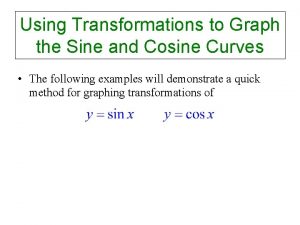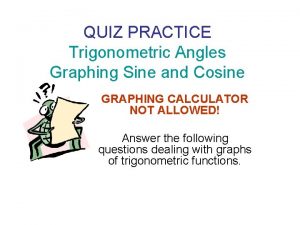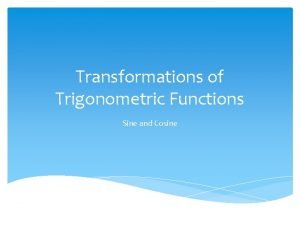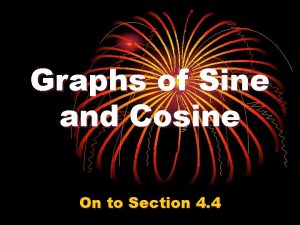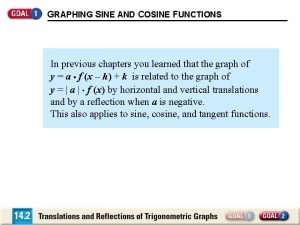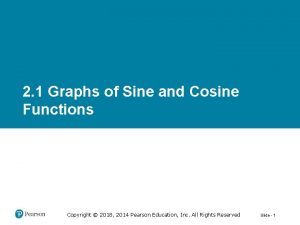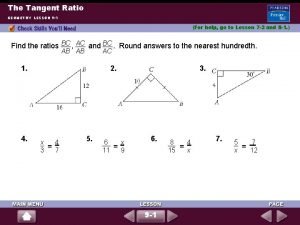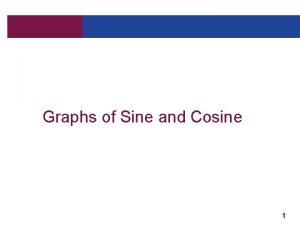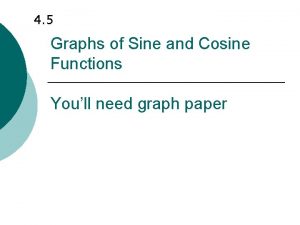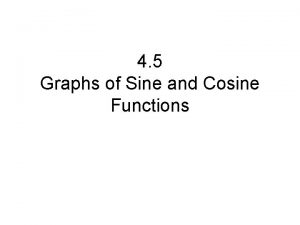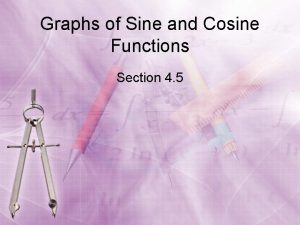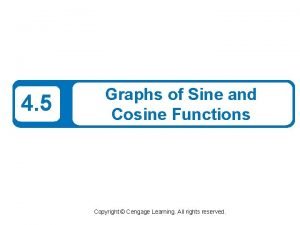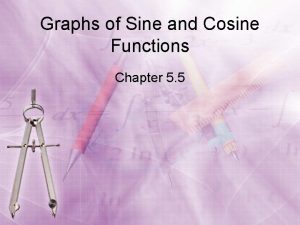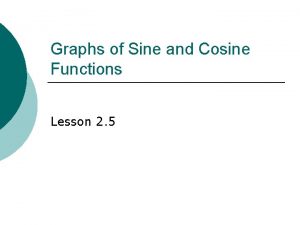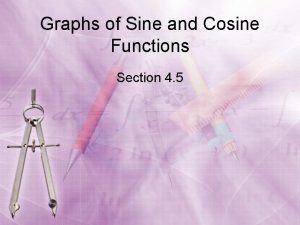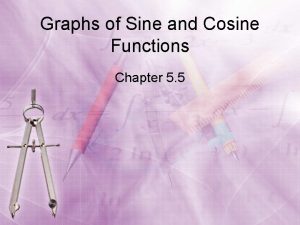1 5 Graphs of Sine and Cosine Functions











![y = 85 sin [(π/20)(t /20)( – 10)] + 90 b. Find the height y = 85 sin [(π/20)(t /20)( – 10)] + 90 b. Find the height](https://slidetodoc.com/presentation_image_h2/70066a02c6e6f43e69c0a301ea4b4170/image-12.jpg)



- Slides: 15

1. 5 Graphs of Sine and Cosine Functions Part 4

Finding a cosine equation by Transformations Construct a cosine equation that rises from a minimum value of y = 4 at x = 0 to a maximum value of y = 20 at x = 30. Solution: Let’s first picture the graph: 20 16 12 8 4 -4 30

Constructing a Sinusoid by Transformations minimum value of y = 4 at x = 0 maximum value of y = 20 at x = 30. The amplitude is half the height. (20 – 4)/2 = 8, so │a│=8. The period is 60, so set (2π)/│b│= 60 │b│= π/30 20 16 12 8 4 -4 30

│a│=8; │b│= π/30 We need a graph with a minimum at (0, 0). It is easiest to take the cosine curve (which has a maximum at x = 0) and turn it upside down. This will make a = -8. So we get y = -8 cos (π/30)x

y = -8 cos (π/30)x This function ranges from a minimum of 8 to a maximum of 8. Shift the graph vertically by 12 to get the function that ranges from 4 to 20. Therefore, y = -8 cos (π/30)x + 12

Sine and cosine functions can be used to model many real-life situations We will do an example using the cyclic motion of a ferris wheel.

Ferris Wheel Suppose you are riding a Ferris wheel. As it turns, your height h (in ft) varies with the time t (in sec): The table shows your height during various times: t(time) 10 20 30 40 50 h (height) 90 175 90 a. Use a trigonometric function to model this data. b. Find the height at 35 sec and 60 sec.

Ferris Wheel EXAMPLE 3 a. Use a trigonometric function to model this data. t(time) h (height) 10 90 20 175 30 90 40 5 50 90 Begin by graphing the data. You can use either a sine or cosine model: Let’s use a sine model.

10 20 30 40 50 h (height) 90 175 90 Your equation will be of the form y = a sin (bt + c) + d maximum value of h = 175 at t = 20 minimum value of h = 5 at t = 40 or t = 0. The amplitude is half the height. (175 – 5)/2 = 85, so │a│=85. The period is 40, so set (2π)/│b│= 40 │b│= π/20 t(time)

y = a sin (bt + c) + d │a│=85 │b│= π/20 • If we look at how much the graph shifted horizontally from a basic sine curve, we get 10 places to the right. • If we look at how much the graph shifted vertically from a basic sine curve, we get 90 units upward.

y = a sin (bt + c) + d │a│=85 │b│= π/20 10 units to right, 90 units upward. y = 85 sin [(π/20)(t /20)( – 10)] + 90
![y 85 sin π20t 20 10 90 b Find the height y = 85 sin [(π/20)(t /20)( – 10)] + 90 b. Find the height](https://slidetodoc.com/presentation_image_h2/70066a02c6e6f43e69c0a301ea4b4170/image-12.jpg)
y = 85 sin [(π/20)(t /20)( – 10)] + 90 b. Find the height at 35 sec and 60 sec. Plug in 35 and 60 for t. Π h = 85 sin (20 (35 – 10)) + 90 =29. 896 ft Π h = 85 sin (20(60 – 10)) + 90 = 175 ft

SUMMARY: Amplitude Period: 2π/b Vertical Shift Horizontal Shift c/b

Classwork Section 1. 5 Worksheet – Applications of Trigonometry Models 1. 1 – 1. 5 Test Monday

Homework Pg 168 – 170 69 – 76, 83 – 86, 93
 Graph of sine and cosine functions
Graph of sine and cosine functions How to find the period of a cosine function
How to find the period of a cosine function 9-5 practice graphing trigonometric functions
9-5 practice graphing trigonometric functions 4-4 graphing sine and cosine functions worksheet answers
4-4 graphing sine and cosine functions worksheet answers Cosine function graph equation
Cosine function graph equation 6-5 practice translations of sine and cosine functions
6-5 practice translations of sine and cosine functions Sine cosine partner
Sine cosine partner Graph of sine and cosine functions
Graph of sine and cosine functions Graph of sine and cosine functions
Graph of sine and cosine functions Graph of sine and cosine functions
Graph of sine and cosine functions Transformations of sine and cosine functions
Transformations of sine and cosine functions Lesson 13-2 sine and cosine ratios answer key
Lesson 13-2 sine and cosine ratios answer key Cosine rule cos a subject
Cosine rule cos a subject Sine and cosine law maze
Sine and cosine law maze Soh cah toa rules
Soh cah toa rules Sine rule angle
Sine rule angle
